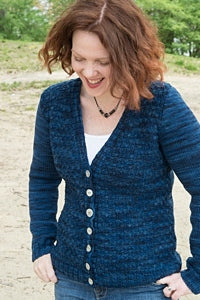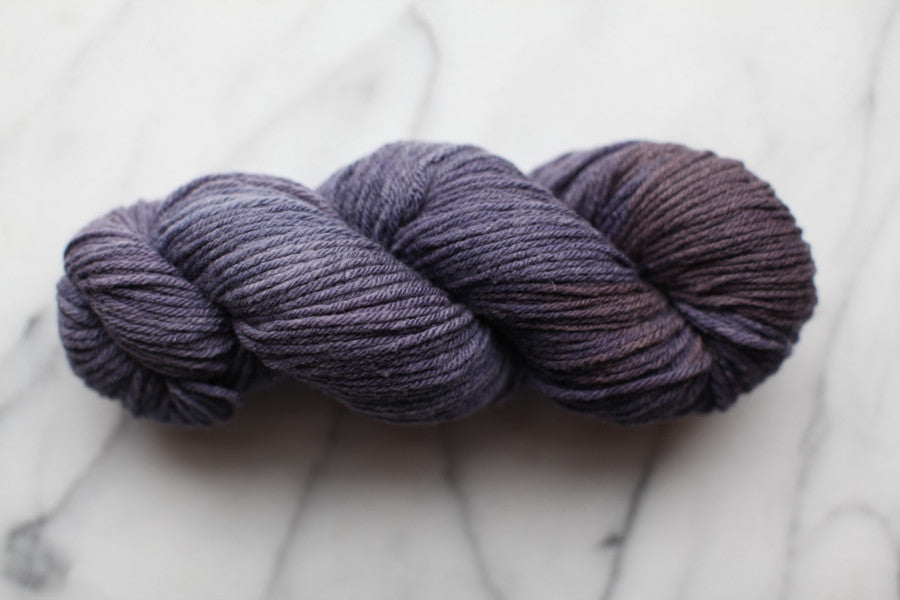Cormo 1.0 Spirit Trail Wisteria
$ 28.00
You may know Jennifer Heverly from her yarns under the Spirit Trail Fiberworks label? Well, right from the start I knew I wanted her to work with Cormo 1.0. I was curious to see how her dye process - which involves pressing dye onto the yarn, rather than just submerging it in a vat and giving it a swirl - would impact the free-spirited crimp in our Cormo.
Compare this to the undyed skeins and you'll notice a distinct wobble in the plies, where the pressure brought out more fiber movement. I consider it a discreet enhanced surface texture. The Cormo has absorbed the dye beautifully, with a rich, full saturation.
I gave her complete free reign to do whatever colors spoke to her. This is one of the two shades she created, a tender cross between lilac and wisteria, with a touch of hyacinth and an occasional dusting of earth. Spring garden hues. She this and Sapphire to play off one-another in case you wanted to do colorwork.
A Note about Color: These are hand-dyed in the true sense of the word. Color is massaged into each skein by hand, and the hues can shift during steaming. Which is to say, there can be some variation in color saturation from skein to skein. We'll pick the very best color matches we can, but I also recommend you alternate skeins every other row. 'Tis the very nature of dye work done by hand in small batches.
Quick Facts about Cormo 1.0
Gauge: This plump, worsted-weight yarn is happiest in the range of 5 to 5.25 stitches per inch, in the 7 rows per inch range. Start with US 7 (4.5mm) needles and see where they get you. Don't be surprised if you need to go up or down. I watched a room full of people swatch this at the Knitter's Review Retreat (and perhaps you were one of those people?) and every single person produced a different fabric.
Put-up: 155 yards (141m)
Skein weight: 94g*
- In the food world, there's something called an "amuse bouche." It's an unexpected little dish, something never found on any menu. It's meant to surprise, delight, but also give the eater a sense of the chef's philosophy about food and cooking.
This yarn is my amuse bouche to you.
It began as I was embarking upon my Great White Bale adventure. I contacted my wool mentor Elsa Hallowell for advice. For years, Elsa shepherded a magical flock of American Cormo sheep. Not just white, which is the breed standard, but varying gorgeous shades of grey. She spun the fibers and sold them under her Elsawool yarn label. Her yarn was, and still is, extraordinary. Pure, even, soulful, both serene and brimming with life. Were I to be stranded on a desert island, hers is the yarn I'd want.
It turns out Elsa was at a turning point in her own life. There is a thing called OPP that sheep farmers dread more than almost anything. Infected sheep can be asymptomatic for a long time. So that when Elsa finally tested her flock for OPP, almost the entire flock tested positive. Which meant that most of the sheep were infected when she bought them. Once the symptoms appeared, one by one, she had to put her flock down. She told me it was one of the most painful things she's ever had to do.
Luckily, she had a friend and fellow farmer in Montana who also raised American Cormo sheep. He offered to sell her his entire yearly clip. It was a lot of wool, she told me, maybe more than she really needed that particular year. But if she didn't commit to the whole shebang, she'd lose it. "I didn't realize you were interested in making yarn," she said, leaving the end of her sentence unfinished.
The lightbulb went off. Elsa agreed, and soon it was settled. We'd share that year's Cormo clip. Which is how I found myself quite suddenly not only the proud owner of the Great White Bale, but two more bales of wool. Glorious Cormo. What you see here came from the first of those two bales.
Source: Wool from purebred American Cormo sheep raised in Montana. Scoured at Bollman's in San Angelo, Texas. Combed, spun, and twisted at Kraemer Yarns in Nazareth, Pennsylvania. Skeined, scoured, and transformed into the skeins you see here at Saco River Dyehouse in Biddeford, Maine. - My goal was to produce an ideal sweater yarn, the kind of yarn that almost leaps off the skein and onto your needles while you aren't looking. I chose a heavier gauge to let Cormo's innate thick sponginess shine through. In fabric, I can't think of anything else I'd want to wrap around my body.
The basic Kraemer preparation involves carding the fibers and then running them through three stages of pin-drafting to align the fibers. We tried spinning straight from here, and the results were surprisingly shaggy and uneven.
The only way to rectify this was to run the pin-drafted fibers through the comb, which further aligns the fibers and removes any short, irregular ones. Those combed fibers were then run through the card again, and the pin-drafters, before being spun.
The results were much smoother, though the yarn still retains a pleasant element of liveliness and subtle, earthy irregularity.
The next step was to settle on a yarn weight. They spun several different variations until we settled on a yarn that looked right, felt right, behaved right on my needles, and delivered a gauge range that would be useful to the most people. While we lost quite a bit of fiber during combing, the process turned out to be vital.
The four-ply construction gives great roundedness, structure, and strength to any fabric. Play with textured stitches--ribbing, seed stitch, moss stitch, staggered purl motifs, you name it--and by all means consider some garter-stitch too.
The yarn's thick, doughy demeanor may not be suitable for lace motifs in which soaring YOs play a big part, since its instinct will be to close them up with a snug fibery hug. But cables? Massive and crisp.
Want to know the real magic in this yarn? It comes after you knit your fabric, snip and darn your ends, and drop the finished material in warm soapy water for the first time. Cormo is a high-crimp fiber. Despite the fact that this yarn has been combed and tamed into submission, it still blooms--a glorious, seductive come-hither bloom--in the wash.
* A fascinating note about humidity and skein weight: The dyehouse was asked to wind off our yarn in 100g skeins, and to go slightly over that to compensate for any loss during washing. But when I brought several sample skeins home, both scoured and un-scoured, I noticed that they all varied in weight, but none weighed 100g. One was 94g, another was 96g, and another came in at 98g. To be safe, I kept the estimate at 94g here.
I'm wondering if the excessive humidity at the dyehouse has something to do with this discrepancy? Or perhaps simply that it's a new dyehouse and they're still figuring things out? I'd be very interested to see what your skeins weigh when they get home, especially if you live in a more humid climate. Another possibility? Perhaps the skeins were wound by two people who have slightly different techniques for tying skeins. Maybe one used more yarn?
Note that the yardage is spot-on from skein to skein, and the weight difference is still only half of what a pen weighs--but it's an interesting phenomenon. You could try this with other skeins in your stash and see how they measure up, too. - In terms of project ideas, the world is our oyster. In addition to the gorgeous designs that used the natural color, you can see the dyed yarn work its magic in Amy Herzog's brand new design, Cushing Isle.

Cushing Isle by Amy Herzog (you can also find the pattern on Ravelry)

Noyac Bay Toque by Jane Cochran
Noyac Bay Cowl by Jane Cochran
Oranmore by Bristol Ivy




